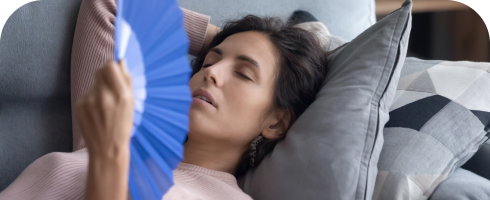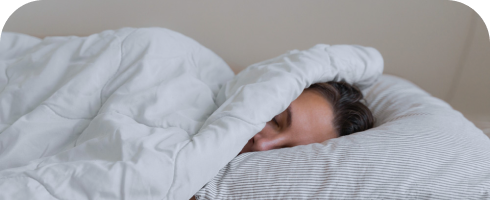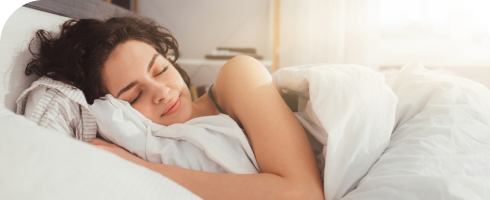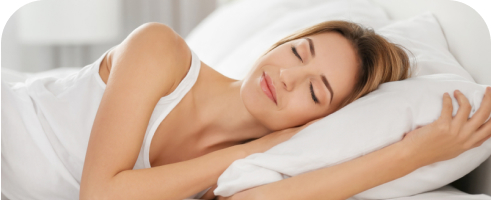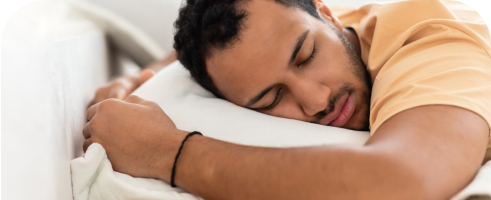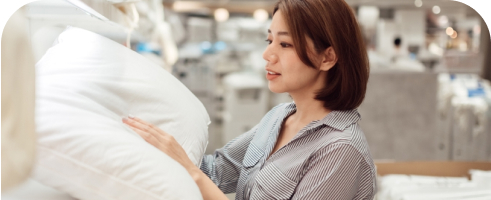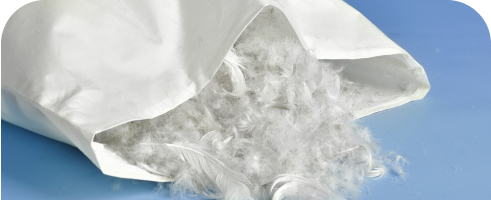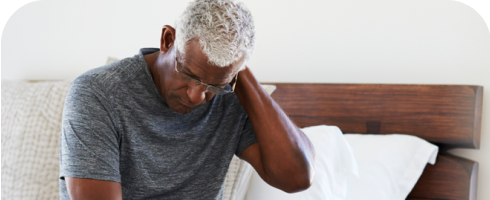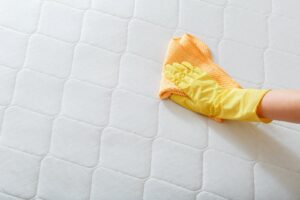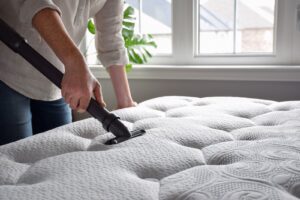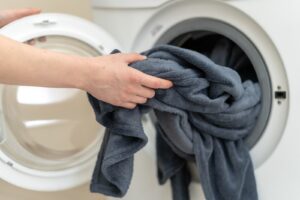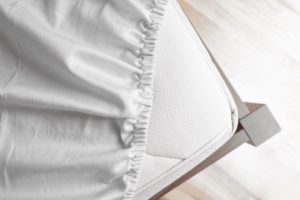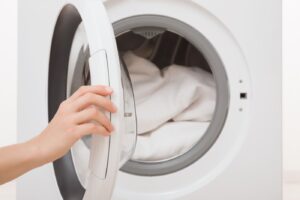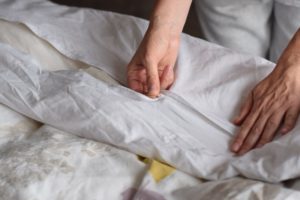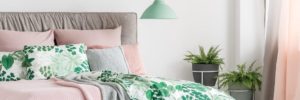Why Do Pillows Turn Yellow
We’ve all had it happen: You buy a pillow, and then yellow stains start to appear on its surface over time. While it might seem like this discoloration is simply a sign of aging, there are actually specific reasons a pillow turns yellow.
Pillows start to turn yellow due to a variety of factors, most of which involve the accumulation of moisture. Sweat, drool, wet hair, and even skincare products can contribute to yellow stains on a pillow. And these stains are more than just unsightly. After a while, they can harbor bacteria and allergens, potentially affecting the quality of your sleep and your health.
We’ll discuss the factors that turn pillows yellow in detail. We’ll also give tips on how to prevent yellow stains, how to remove them, and how to identify when it’s time to replace your pillow.
Find a Pillow That’s Right for You
Looking for a new pillow? Take the quiz below to find the perfect pillow for your needs.
Trouble sleeping?
Answer these 5 easy questions to discover your perfect pillow

Trouble sleeping?
Answer these 5 easy questions to discover your perfect pillow
What position do you sleep in?

Side
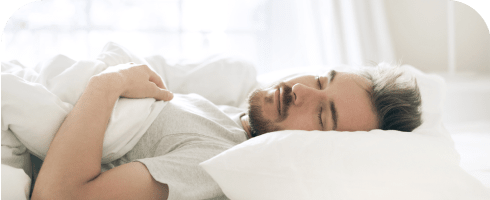
Back

Stomach
Why Pillows Turn Yellow
As you sleep, different types of bodily moisture can accumulate on your pillowcase. When this moisture seeps through, it can stain your pillow yellow. Though sweating is a frequent source of pillow discoloration, there are other common culprits.
Sweat
While excessive sweating at night can be a sign of a more serious health condition, a certain amount of sweating during sleep is a normal way the body regulates temperature. However, sweat can also leak through your pillowcase and cause yellow stains.
There are certain things you can do to minimize this process, though. Sleeping in a cooler room or wearing lighter pajamas are just a couple strategies to mitigate night sweats and keep your pillow from turning yellow.
Wet Hair
For people with long hair who shower at night, going to bed with wet hair might seem unavoidable. However, damp hair acts much like sweat when it comes to turning a pillow yellow. The water left over from a nighttime shower can penetrate your pillowcase, causing yellow stains and discoloration. Showering in the morning or leaving adequate time between a shower and bedtime can ensure drier hair and less moisture on your pillow.
Drool
Allergies, acid reflux, and teeth grinding are just a few of the reasons why you might drool in your sleep. Back sleepers are less prone to drooling than those who sleep on their stomach or side. By addressing the causes of drooling, you can help limit excess moisture on your pillow.
Skin and Hair Oil
The parts of the body responsible for producing hair and skin oil are called sebaceous glands. These glands work by producing a substance called sebum, which is critical to dermatological health. However, overactive sebaceous glands can lead to oily skin or hair. This excess oil can then absorb into your pillow and make it turn yellow.
Lotions, Face Creams, and Beauty Products
Whether it’s simply washing your face or applying various lotions or creams, many people have a nightly skincare routine. When you rub these beauty products on your face right before bedtime, though, they might not have adequate time to absorb into your skin. Unabsorbed skincare products can seep into your pillow and contribute to discoloration and stains.
Sleeping on a Pillow Stained Yellow
No product lasts forever, and over time, even the best pillow can turn yellow. However, there are a couple reasons why sleeping on a discolored pillow could disturb your sleep or even be bad for your health.
The first is the presence of allergens. Over time, dust mites, mildew, and other allergens can build up in a pillow, especially one that’s been significantly affected by moisture. When these allergens accumulate, they can cause allergic reactions that may make it harder to sleep. Lack of sleep in turn can lead to a weakened immune system and other health issues.
The sweat, oil, and dead skin cells that turn a pillow yellow can also clog pores and potentially cause skin breakouts. Pillows can also be a source of bacterial buildup over time. We recommend replacing your pillow every one to two years or if it shows signs of excessive discoloration.
How to Prevent Your Pillows From Turning Yellow
In addition to trying to minimize the amount of moisture you get on your pillow, there are certain steps you can take to better insulate your pillow and extend its lifespan.
- Use a pillow protector. A pillow protector is a sealed layer of fabric that goes between your pillowcase and your pillow. Pillow protectors act as one more layer between your pillow and the moisture that can discolor it.
- Use a good pillowcase. No two sleepers are the same, and different sets of bed linens are better suited to different types of sleepers. That said, pillowcases with higher-quality construction are more likely to keep moisture away from your pillow and slow down the yellowing process.
How to Remove Yellow Stains From Your Pillow
While pillow protectors and quality pillowcases can help prevent yellow stains, it’s difficult to completely protect your pillow from discoloration. If you notice your pillow starting to turn yellow, there are certain things you can do to try to remove these stains.
- Read care instructions. Pillows have varying care guidelines depending on their materials and construction. For example, while certain pillows are machine-washable, some are too delicate and must be taken to a dry cleaner or spot-cleaned. Before you try to remove yellow stains, make sure you’re familiar with the manufacturer’s care instructions so you don’t damage your pillow.
- Spot-treat stains. If your pillow isn’t machine-washable, you can spot-clean yellowed areas. Spot-cleaning involves carefully applying soap or another cleaning agent to the affected area, then wiping and washing it off using a small amount of water. By repeating this process, you can decrease the severity of yellow stains.
- Use bleach. By soaking a yellow stain in bleach before washing, you can help get your pillow’s color back to normal. Be careful, though: Bleach is a harsh chemical product and not all pillows can be bleached without damage. Make sure to carefully study your pillow’s care instructions before using bleach.
Why It’s Important to Keep Pillows Clean
The first reason why it’s important to clean your pillow is simple: longevity. Like all products, pillows degrade over time, but when you properly care for a pillow, you can prolong its lifespan.
Maintaining a clean sleep environment can help you get restful sleep by minimizing distractions like allergens or odors. And a good night’s sleep affects almost every aspect of your health, from brain, heart, and immune system functions to alertness and mood, making pillow maintenance a simple way to improve sleep hygiene.

Still have questions? Ask our community!
Join our Sleep Care Community — a trusted hub of sleep health professionals, product specialists, and people just like you. Whether you need expert sleep advice for your insomnia or you’re searching for the perfect mattress, we’ve got you covered. Get personalized guidance from the experts who know sleep best.

